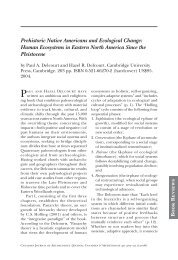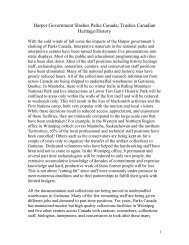tethered in place 40m west of the wreck. From its positioning, size, and weight, it wouldseem logical to conclu<strong>de</strong> that this was a bow anchor located on the starboard si<strong>de</strong>.Strangely, this was the only anchor found on the Machault site. Other abnormalities cameto light as well. This paper is the object of a case study in which the Machault anchor’sirregularities and unique craftsmanship will be discussed.Gelé, Agnès (Université Laval) La verrerie <strong>de</strong> table française en Amérique du Nor<strong>de</strong>ntre 1650 et 1760 (12) En archéologie historique, les artefacts en métal et céramiquesont étudiés quasi-systématiquement, entre autre à <strong>de</strong>s fins <strong>de</strong> datation. Ce n’est pas le caspour la verrerie <strong>de</strong> table, moins facile à appréhen<strong>de</strong>r et qui nécessite souvent un recours àl’archéométrie. Dans le cadre d’un doctorat à l’université Laval, j’entreprends une étu<strong>de</strong><strong>de</strong> la verrerie <strong>de</strong> table française en Amérique du Nord, en me penchant plusparticulièrement sur les collections québécoises et <strong>de</strong> la Guyane Française pour la pério<strong>de</strong>1650-1760. Il s’agit <strong>de</strong> présenter cette recherche, qui a pour objet <strong>de</strong> spécifier ce qu’estsusceptible <strong>de</strong> nous apporter l’étu<strong>de</strong> <strong>de</strong> ce mobilier, <strong>de</strong> déterminer entre autre sil’établissement d’une typo-chronologie précise liée à <strong>de</strong>s données d’ordre compositionnelpourrait permettre d’utiliser la verrerie <strong>de</strong> table comme élément <strong>de</strong> datation fiable, <strong>de</strong>renseigner les échanges commerciaux dans la zone Atlantique nord et <strong>de</strong> voir s’il estpossible d’observer <strong>de</strong>s données d’ordre social par l’étu<strong>de</strong> <strong>de</strong> ce mobilier.Gendron, Daniel (Institut culturel AVATAQ) Old and New Challenges in CulturalManagement in Nunavik (16) Avataq created its Department of Archaeology 27 years agoto look after the archaeological resources of Nunavik. Its mandate was given by the El<strong>de</strong>rsConference. The Department has been carrying all manners of projects from salvageexcavations, CRM, and long-term research projects. Always having to <strong>de</strong>al with twolevels of Government: Provincial for the mainland, and Fe<strong>de</strong>ral (now Nunavut for theislands). Although there have been a <strong>number</strong> of management plans <strong>de</strong>vised, there hasnever been one aimed specifically at cultural management. Avataq has always worked outof the good will of the regional government and municipalities and landholdingcorporations. The upcoming implementation of the Plan Nord will necessitate theelaboration of a more concrete and solid management plan. This presentation focuses onthe various ways in which archaeology has been carried out and how it should be<strong>de</strong>veloped from this point on.Gervais, Mélanie Johnson (Université <strong>de</strong> Montréal) Pêcheries et échangestransatlantiques au Régime français : Étu<strong>de</strong> <strong>de</strong> la répartition géographique <strong>de</strong>s grèsgrossiers français en Nouvelle-France (31) Les <strong>de</strong>rnières décennies ont vues quelquesrares étu<strong>de</strong>s concernant le grès grossier français retrouvé sur le territoire <strong>de</strong> la Nouvelle-France. Pourtant, ces céramiques ont beaucoup à dire sur les groupes humains et lescontextes dans lesquels ils étaient utilisés et échangés durant le Régime français. Lalittérature existante démontre que les grès français sont généralement retrouvés dans lescontextes archéologiques maritimes, d’où ils offrent un aperçu privilégié sur les activités<strong>de</strong>s marchands et <strong>de</strong>s marins normands et basques qui voguèrent vers l’Amérique duNord. Le but <strong>de</strong> notre recherche documentaire était d’examiner les tendances etd’augmenter notre connaissance du grès français retrouvés sur les sites archéologiquesquébécois principalement, mais aussi dans les régions maritimes canadiennes. Nousdésirions ainsi cartographier avec plus <strong>de</strong> précision les interactions entre les groupes
impliqués dans les pêcheries et les échanges transatlantiques au Régime français. Cetteaffiche se veut une présentation <strong>de</strong>s principaux tableaux et cartes émanant <strong>de</strong> notre étu<strong>de</strong>.Gibson, Terrance (Western Heritage, St Albert) Magnetic Susceptibility: Explorationsin the Detection and Excavation of the Intangible in Thun<strong>de</strong>r Bay's AncientArchaeological Record (19) In previous papers at the CAA I have provi<strong>de</strong>d a <strong>number</strong>examples showing that near surface geophysical surveys, using gradiometers andmagnetometers, can help to localize archaeological fire hearths, since they regularlyproduce faint but <strong>de</strong>tectable magnetic anomalies that can be mapped with good precisionon a site. This is caused by a steady conversion of the natural iron compounds in soils intomagnetically susceptible ones during the repeated heating and cooling conditionsencountered for most archaeological hearths. Magnetically susceptible soil appears to beprofoundly enduring in a soil profile even as the visible components of hearths maycompletely disappear over time. The challenge is to find these soil remnants that areinvisible and for all intents and purposes intangible. For several years the author hascoordinated an intensive effort to do this through the collection of tens of thousands ofsoil samples from a <strong>number</strong> of PalaeoIndian excavations in the Thun<strong>de</strong>r Bay district. Theeffort to collect these soils has been great, and has produced interesting results, but it hasinevitably led to a serious re-evaluation of the data recovery process. Regular soilsampling, though laudable in its goals, is not without its pitfalls, not only in the effortneed to collect the soils, but also in their laboratory measurement. The author's mostrecent efforts have taken a new direction, moving from soil collection and post-excavationprocessing to direct in-situ measurement of susceptibility. This approach promises to beeasier, faster and has the potential to produce immediate results that could help in thei<strong>de</strong>ntification of intangible hearths while excavation proceeds.Gilbert, Louis Le site <strong>de</strong> la maison du gouverneur <strong>de</strong> Varennes à Trois-Rivières (CcFd-20) : bilan <strong>de</strong> 3 saisons <strong>de</strong> chantier-école archéologique (29) En 2009, le chantier-écolearchéologique du Collège Laflèche commençait l’exploration d’un nouveau site <strong>de</strong>l’arrondissement historique <strong>de</strong> Trois-Rivières. Après une première saison plutôtdécevante, qui avait tout <strong>de</strong> même permis <strong>de</strong> s’assurer <strong>de</strong> la présence <strong>de</strong> sols anciens nonperturbés dans un secteur à risque, les résultats obtenus ont permis <strong>de</strong> dresser uneséquence d’occupation <strong>de</strong> ce secteur allant d’avant 1674 jusqu’à la fin du XIXe siècle.Des vestiges <strong>de</strong> la maison <strong>de</strong> René Gaultier <strong>de</strong> Varennes, <strong>de</strong>uxième gouverneur <strong>de</strong> la ville,ont été mis au jour, ainsi que <strong>de</strong>s indices d’une occupation ouvrière du XIXe siècle. Cesfouilles, réalisées par <strong>de</strong>s étudiants en Histoire et Civilisation du Collège Laflèche, ontpermis <strong>de</strong> jeter un regard nouveau sur un site qui était jusqu’alors mal connu et <strong>de</strong>confirmer son potentiel archéologique.Gilliland, Krista (Western Heritage, St. Albert, AB) The Hearth and the Hummock: Asediment-based record of cultural activities at the Fort Denison site near Humboldt,Saskatchewan (31) Two key features were recovered during excavations at Fort Denison.The first is a hearth <strong>de</strong>monstrating multiple uses, and the second is a low sandy hill-likefeature boun<strong>de</strong>d by upper and lower layers of clay-rich sediment, interpreted asrepresenting a <strong>de</strong>fensive trench or zareba. The working hypothesis is that both featuresdate to the military occupation of the fort, and geoarchaeological work was un<strong>de</strong>rtaken to
- Page 1 and 2: RÉSUMÉS / ABSTRACTSPar ordre alph
- Page 3 and 4: glyphs in images for posterity have
- Page 5 and 6: Balac, Anne-Marie (Ministère de la
- Page 8: Bergeron, André (Centre de conserv
- Page 12 and 13: forme traditionnelle imprimée ou d
- Page 14: after learning about what happened
- Page 17 and 18: Cadieux, Nicolas, Jean-Christophe O
- Page 19: known in the area, both historic an
- Page 22 and 23: Comeau, Jennifer (Memorial Universi
- Page 24 and 25: in single households. Given that th
- Page 27 and 28: Crompton, Amanda (Memorial Universi
- Page 29 and 30: describe the spatial extent of the
- Page 31 and 32: Columbia. Although dogs are not a d
- Page 33 and 34: planification des fouilles archéol
- Page 35 and 36: synthèse des données biophysiques
- Page 37 and 38: Ellis, Christopher (University of W
- Page 39 and 40: ever made in an archaeological site
- Page 41: qui occupait déjà l’esprit des
- Page 45 and 46: préhispaniques. Parmi ces camélid
- Page 47 and 48: archaeometrists these days is a tec
- Page 49 and 50: patches undertaken to identify the
- Page 51 and 52: integration of feature, artifact an
- Page 53 and 54: l’appellation crie désignant les
- Page 55 and 56: order to ensure there was no damage
- Page 57 and 58: in 1851 as a market and destroyed i
- Page 59 and 60: devait tenir compte des grands prin
- Page 61 and 62: elusive has been a consistent way o
- Page 63 and 64: driving forces in Québec archaeolo
- Page 65 and 66: Ly, Yvonne (Archéotec inc.) Essai
- Page 67 and 68: contribution de Google Earth à la
- Page 69 and 70: to its taphonomic agent. These obse
- Page 71 and 72: Monchot, Hervé (Université Paris
- Page 73 and 74: horticulturalists. Broad-bladed bif
- Page 75 and 76: Oetelaar, Gerald (University of Cal
- Page 77 and 78: Paxton-MacRae, Mark (Western Herita
- Page 79 and 80: 19 th and 20 th centuries. Old-grow
- Page 81 and 82: while deer, particularly white tail
- Page 83 and 84: Rankin, Lisa K. (Memorial Universit
- Page 85 and 86: Robinson IV, Francis (University at
- Page 87 and 88: Royer, Martin (Ethnoscop inc.) Inve
- Page 89 and 90: Sifontes, Sarah (York University) D
- Page 91 and 92: isotopique par spectrométrie de ma
- Page 93 and 94:
quarries have been discovered and e
- Page 95 and 96:
aux XVII e et XVIII e siècles (25)
- Page 97 and 98:
last rapids of St. Laurence river.
- Page 99 and 100:
Woods, Audrey (Université de Montr
- Page 101 and 102:
theorizing material culture, much o








